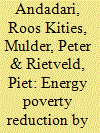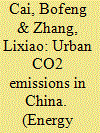|
|
|
Sort Order |
|
|
|
Items / Page
|
|
|
|
|
|
|
| Srl | Item |
| 1 |
ID:
128035


|
|
|
|
|
| Publication |
2014.
|
| Summary/Abstract |
Gujarat, a large industrialized state in India, consumed 67 TWh of electricity in 2009-10, besides experiencing a 4.5% demand-supply short-fall. Residential sector accounted for 15% of the total electricity consumption. We conducted load research survey across 21 cities and towns of the state to estimate residential electricity load curves, share of appliances by type and usage patterns for all types of household appliances at utility, geographic, appliance, income and end-use levels. The results indicate that a large scope exists for penetration of energy efficient devices in residential sector. Marginal Abatement Cost (MAC) curves for electricity and CO2 were generated to analyze relative attractiveness of energy efficient appliance options. Results indicate that up to 7.9 TWh of electricity can be saved per year with 6.7 Mt-CO2 emissions mitigation at negative or very low CO2 prices of US$ 10/t-CO2. Despite such options existing, their penetration is not realized due to myriad barriers such as financial, institutional or awareness and therefore cannot be taken as baseline options for CO2 emission mitigation regimes.
|
|
|
|
|
|
|
|
|
|
|
|
|
|
|
|
| 2 |
ID:
127886


|
|
|
|
|
| Publication |
2014.
|
| Summary/Abstract |
The number of multi-family housing complexes (MFHCs) over 15 yr old in South Korea is expected to exceed 5 million by 2015. Accordingly, the demand for energy retrofit in the deteriorating MFHCs is rapidly increasing. This study aimed to develop a decision support model for establishing the optimal energy retrofit strategy for existing MFHCs. It can provide clear criteria for establishing the carbon emissions reduction target (CERT) and allow efficient budget allocation for conducting the energy retrofit. The CERT for "S" MFHC, one of MFHCs located in Seoul, as a case study, was set at 23.0% (electricity) and 27.9% (gas energy). In the economic and environmental assessment, it was determined that scenario #12 was the optimal scenario (ranked second with regard to NPV40 (net present value at year 40) and third with regard to SIR40 (saving to investment ratio at year 40). The proposed model could be useful for owners, construction managers, or policymakers in charge of establishing energy retrofit strategy for existing MFHCs. It could allow contractors in a competitive bidding process to rationally establish the CERT and select the optimal energy retrofit strategy. It can be also applied to any other country or sector in a global environment.
|
|
|
|
|
|
|
|
|
|
|
|
|
|
|
|
| 3 |
ID:
127944


|
|
|
|
|
| Publication |
2014.
|
| Summary/Abstract |
ACM, Active Community Member, person that takes the initiative to fill out an application on behalf of a community; Seed, randomly selected ACM that allowed us to start collecting information; Ego, person that is interviewed. An Ego can also be an Alter, if it is mentioned by another Ego; Alter, people that provided (Type 1) or received (Type 2) information, as recalled by the Ego; Type 1 edge, an information flow in which an Alter provides information to an Ego; Type 2 edge, an information flow in which an Ego provides information to an Alter; Student, a person whose main occupation is to go to school; Radio, a message spread through the radio. Usually local stations in which an individual is interviewed; Internet, information about the stoves posted on Proyecto Mirador's Website; Maquila, a person that works at a factory for an international company, textile and food processing factories are usual; Agriculture, a peasant that works on agriculture, regardless of land tenancy; Health, a nurse, doctor or other health worker; Church, a priest, nun, minister or person who works as a minister of a faith; Education, a person who works as a school teacher or university professor; PM or PM associates, direct employees of Proyecto Mirador and its Implementers; Other NGO, a person that works on other non-governmental organizations. For example, Peace corps, Hivueras, Plan Honduras; Local, a local leader that has an appointment in the community but does not receive a monetary compensation. For example, members of the water board, village councils; Housewife, a woman whose main occupation is to keep the house; Business, a person that does commerce or services, includes people that sell food informally, artisans, masons, etc.; Government, a person who works directly for the government (except education and health practitioners); PM employees, direct employees without the implementers
|
|
|
|
|
|
|
|
|
|
|
|
|
|
|
|
| 4 |
ID:
127998


|
|
|
|
|
| Publication |
2014.
|
| Summary/Abstract |
Sustainability is fundamentally a challenge of tradeoffs. In order to improve human well-being through economic development we consume nonrenewable energy and other natural resources, relying on a broad range of ecosystem services. Enhancing sustainability requires reducing the "energy intensity of human well-being (EIWB)": the amount of energy used per unit of human well-being. In this study we employ longitudinal analysis techniques to assess the temporally dynamic relationship between EIWB and economic development for a sample of 12 Central and Eastern European (CEE) nations for the 1992 to 2010 period. These are nations that have recently transitioned, which is still an ongoing process, from socialist command economies to market demand economies. During this ongoing transition, many of them have experienced declines in energy intensity, coupled with increased energy efficiency, while human well-being has improved considerably. The results of the analysis indicate that the relationship between EIWB and economic growth in CEE nations is complex and has changed dramatically through time. Of particular importance, the later years of the study exhibit an increasingly sustainable relationship between EIWB and economic development. The findings point to future possibilities for relatively more harmonious relationships between development, human well-being, and the natural environment.
|
|
|
|
|
|
|
|
|
|
|
|
|
|
|
|
| 5 |
ID:
128000


|
|
|
|
|
| Publication |
2014.
|
| Summary/Abstract |
In low- and middle-income countries, Liquefied Petroleum Gas (LPG) can be an attractive alternative to the widespread use of traditional kerosene. Not only is LPG a relatively clean, safe and cost-effective fuel for households, its large-scale adoption also reduces the heavy burden of kerosene consumption subsidies on government budgets. Against this background, we evaluate the impact of a large government program to substitute LPG for kerosene in Indonesia. Using a household survey across urban, suburban and rural regions we find that this program was very effective in causing a large scale shift from kerosene to LPG. This shift was positively influenced by level of education, household size and household income. Contradicting the energy-ladder model, the LPG program, reinforced by an increase in the price of kerosene, led to increased stacking of fuels, including increasing consumption of both electricity and traditional biomass. In addition, our analysis shows that the LPG program failed to substantially reduce the overall number of energy-poor people, but it has been effective in alleviating extreme energy-poverty. Finally, we find that medium and higher income households in suburban areas benefitted most from the LPG program.
|
|
|
|
|
|
|
|
|
|
|
|
|
|
|
|
| 6 |
ID:
132665


|
|
|
|
|
| Publication |
2014.
|
| Summary/Abstract |
According to the 2011 Census of India, over 31% of India×s 1.2 billion people lived in nearly 8000 towns and cities; the remaining 830 million people lived in over 638,000 villages. About 55% of rural households and 93% of urban households had access to electricity. The 2005 Indian Human Development Survey showed that on average, electricity availability (hours of supply per day) in rural and urban households were 14 and 19 h, respectively ( Desai et al., 2007). Using nationally representative data from Indian Human Development Survey, this study estimated the impact of electricity access and availability on two attributes of human well-being, viz. education and health attainment. It found a significant positive relationship between electricity availability and well-being in rural and urban households. Electricity accessibility, revealed a significant positive relationship only for rural households. The paper concludes with implications for electricity policy and infrastructure choices.
|
|
|
|
|
|
|
|
|
|
|
|
|
|
|
|
| 7 |
ID:
128053


|
|
|
|
|
| Publication |
2014.
|
| Summary/Abstract |
Technological change has often been presented as a readily accepted means by which long-term greenhouse gas (GHG) emission reductions can be achieved. Cities are the future centers of economic growth, with the global population becoming predominantly urban; hence, increases or reductions of GHG emissions are tied to their energy strategies. This research examines the likelihood of a developed world city (the Greater Toronto Area) achieving an 80% reduction in GHG emissions through policy-enabled technological change.
Emissions are examined from 3 major sources: light duty passenger vehicles, residential buildings and commercial/institutional buildings. Logistic diffusion curves are applied for the adoption of alternative vehicle technologies, building retrofits and high performance new building construction. This research devises high, low and business-as-usual estimates of future technological adoption and finds that even aggressive scenarios are not sufficient to achieve an 80% reduction in GHG emissions by 2050. This further highlights the challenges faced in maintaining a relatively stable climate. Urban policy makers must consider that the longer the lag before this transition occurs, the greater the share of GHG emissions mitigation that must addressed through behavioural change in order to meet the 2050 target, which likely poses greater political challenges.
|
|
|
|
|
|
|
|
|
|
|
|
|
|
|
|
| 8 |
ID:
128033


|
|
|
|
|
| Publication |
2014.
|
| Summary/Abstract |
Different names/concepts and therefore different spatial boundaries for cities in China are responsible for the conflicting and confusing results associated with urban CO2 emissions accounting. In this study, four types of urban boundaries, i.e., city administrative boundary (UB1), city district boundary (UB2), city built-up area (UB3) and urban proper (UB4), were identified and defined. Tianjin was subsequently selected as the case city to illustrate the different performances of CO2 emissions with respect to these four boundaries using a 1-km grid dataset built bottom-up by point-emission sources. Different urban boundaries can induce a difference in CO2 emissions as large as 654%. UB1 and UB2 are not the appropriate proxies for urban boundaries in the analysis of urban CO2 emissions, although UB1 is a widely adopted boundary. UB3 is a good representative of city clusters and urban sprawl in a certain region, whereas UB4 is the appropriate system boundary for such issues as urban CO2 emissions in light of landscape characteristics and pertinent human activities, as well as the comparability to counterparts in developed countries. These results provide sound policy implications for the improvement of urban energy management and carbon emission abatement in China.
|
|
|
|
|
|
|
|
|
|
|
|
|
|
|
|
|
|
|
|
|